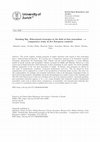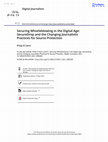Papers by Philip Di Salvo

Digital Journalism, 2024
Revelations from the 2021 "Pegasus Project" investigation into the use of spyware have confirmed ... more Revelations from the 2021 "Pegasus Project" investigation into the use of spyware have confirmed long-held concerns about the proliferation of the technology as a surveillance solution to monitor the activities of journalists around the world. Spyware is a particularly malicious form of malware that can potentially expose a target's entire digital life, sometimes even leaving victims powerless to prevent an attack. As such, spyware appears to be the ultimate tool of oppression that can be used against journalists, and its proliferation is currently taking place with extremely limited transparency and according to "black box" dynamics. The aim of this paper is to shed light on how spyware technology can affect the work and security of journalists by analyzing what threats spyware poses to the practice of journalism. Qualitative and exploratory in nature, and theoretically grounded in surveillance studies and the growing body of literature on information security in journalism, the article is based on a series of qualitative interviews with technologists and reporters conducted to deepen the understanding of the threats posed by spyware and to provide an overview of potential resistance and neutralization practices that journalists can put in place, as well as their effectiveness. Overall, the article aims to contribute to the study of the impact of surveillance on journalism and its implications for press freedom.
The Human Error Project, Mar 4, 2024
The Human Error Project , 2022

First Monday, 2022
In a time when socially impactful technology plays a central part in a variety of political and s... more In a time when socially impactful technology plays a central part in a variety of political and societal dynamics and processes, new forms of secrecy have emerged. The “black box” metaphor is used to define socio-technical systems that operate in non-transparent and prone-to-abuse ways. Frequently, Big Tech companies, their platforms, services and practices have been described as such, especially for their secretive nature and lack of transparency. Whistleblowers and leaks have contributed extensively and at various levels to the understanding of these systems, providing otherwise unaccessible information for public debate. Based on the discussion of a series of recent instances and a review of the available literature, this paper discusses the peculiarities of whistleblowing from Big Tech companies, and how the practice is helping to shed light on various and new technological black boxes and secrecy, while also expanding the scope of whistleblowing itself.

TECNOSCIENZA: Italian Journal of Science & Technology Studies, 2022
This article discusses digitization weaknesses, biases, and mal-
functions to challenge popular, ... more This article discusses digitization weaknesses, biases, and mal-
functions to challenge popular, almost hegemonic visions of contemporary
technologies. By focusing on examples provided by recent mediated cases,
controversies, and critical research about biases, we aim to propose an
analysis of anything digital starting from its vulnerabilities, to look beyond
polarized deterministic views, both optimistic and pessimistic. The article
generates from the thematic track: “Weak Systems. Exploring bias, bugs
and the vulnerability of digitization” that took place at the VIII STS Italia
Conference. The panel brought together scholars from different back-
grounds, including STS, history of technology, sociology of communication
and critical data and media studies to discuss instances of technological
weaknesses in various contexts. The article sums up some of the panel
takeaways and pleas for a cooperative and interdisciplinary effort focusing
on “weak systems”.

Sociology Compass, 2022
Information security (infosec) has become a field of primary interest for journalism, especially ... more Information security (infosec) has become a field of primary interest for journalism, especially in the wake of the 2013 Edward Snowden revelations about the ramifications of Internet mass surveillance. Following the increasing dangers posed by digital threats-and surveillance in particular-to the safety of journalists and their sources, newsrooms and reporters have shown an increased interest in technological solutions for improved protection of their work and sources. In particular, the adoption of strong encryption tools for communication purposes has become an urgent matter for journalists worldwide, becoming a niche of research in journalism studies as well. By reviewing the existing literature in the field, this article examines how journalism studies approach the use of encryption and information security tools for journalistic purposes. Based on research on the major journalism studies journals and other publications, the article offers an overview of the research advancements, highlighting current major trends and research areas.

Studies in Communication Sciences (SComS) , 2020
In the last couple of years, hybridity has become a buzzword in journalism studies. Hybridity has... more In the last couple of years, hybridity has become a buzzword in journalism studies. Hybridity has often been used to describe ongoing transformations in journalism. In this sense, the increasing use of hybridity in the discipline can be seen as an answer, as Witschge, Anderson, Domingo and Hermida (2019, p. 652) declare, “to rising complexity in both journalism practice and scholarship”. At the same time, however, the use of the concept has itself become an object of scholarly debate: while some reject the notion as an undercomplex “catch-all” concept, others believe in its heuristic and analytical prowess. This debate is reinforced by the multiple connotations attributed to the notion, and how the term is used in positive (“a capacity for growth”; Stross, 1999, p. 257) or negative (“diluted version of [the] antecedents”; Chadwick, 2013, p. 14) senses. Either way, hybridity’s success in journalism studies certainly reflects an emancipation from conventional journalism theory, and as a call to develop “new conceptualizations, terminology, and vocabulary” (Witschge et al., 2019, p. 652) in order to grasp the current transformations in journalism – and the different forms of journalism that go beyond traditional understandings and definitions of journalism.

Journalism Studies, Nov 16, 2020
WikiLeaks has often been criticized for being an organization seeking transparency without being ... more WikiLeaks has often been criticized for being an organization seeking transparency without being transparent and accountable itself. The paper aims to shed light on how whistleblowing platforms understand transparency and accountability with regard to their own activities and how and whether they implement online-based practices of accountability and transparency. Drawing on the conceptual model of online media accountability developed by Domingo and Heikkilä, the paper analyzes four whistleblowing platforms: the Hungarian MagyarLeaks, the Dutch PubLeaks, the Italian IrpiLeaks and the German Briefkasten of the weekly newspaper Die Zeit. This study is based on a two-step methodological approach, applying first a document analysis of publicly accessible information on online practices of accountability and transparency; second, we present findings from in-depth interviews with selected editors from each whistleblowing platform. The study critically discusses the evidence of specific c...
SSRN Electronic Journal
COVID-19 is the first global pandemic to emerge on such a wide scale and to such grave effect in ... more COVID-19 is the first global pandemic to emerge on such a wide scale and to such grave effect in an advanced phase of so-called “datafied society”. It lays bare the nuances of a society undergoing digital data transformation in nearly every field of human activity, from its most beneficial to its most disturbing aspects. Four distinct tendencies have emerged: “unquestioning positivism”, “information disorder”, “digital vigilantism” and the “normalisation of surveillance”. This article explores these tendencies and elaborates on the necessary antibodies to counteract them.

Journalism, 2015
The article explores training programs in higher education with regard to data journalism from a ... more The article explores training programs in higher education with regard to data journalism from a multi-national perspective. By carrying out a comparative analysis in six European countries (Germany, Switzerland, the Netherlands, Italy, Poland, and the United Kingdom), it covers different models of media systems and journalistic cultures envisaged by Hallin and Mancini. Based on a desk review and in-depth interviews with instructors of data journalism in each country, the article identifies different approaches to the way data journalism is taught. In Europe, such programs are offered by four types of organizations: academic, vocational, professional, and civic. The role played by those organizations can be explained as a result of the peculiarities of national media systems. But there are also commonalities, for example, non-academic institutions (such as the European Journalism Center or the Center for Investigative Journalism) and major international news outlets (such as The Gua...

Journalism Practice, 2021
Internet surveillance has become a crucial issue for journalism. The “Snowden moment” has shed li... more Internet surveillance has become a crucial issue for journalism. The “Snowden moment” has shed light on the risks that journalists and their sources face while communicating online and has shown how journalists themselves can be targets of surveillance operations or other forms of malicious digital attacks from different actors. More recent revelations, such as those coming from the “Pegasus Project”, have underlined even more dangerous threats posed to the safety of journalists, increasingly targeted with spyware technology. Due to the sensitivity of their work and sources and given their strong “watchdog” role in democracies, investigative reporters are in a particularly dangerous position when it comes to the potential chilling effects of surveillance on their work of journalists. This paper analyzes investigative journalists’ views and self-reflections on the impacts of Internet surveillance on their work by means of in-depth qualitative interviews with reporters affiliated with the International Consortium of Investigative Journalists (ICIJ) and working in Italy, Germany, Hungary, Spain, Switzerland, and the UK. The paper touches on different angles of the Internet surveillance issue by analyzing journalists’ concerns about national and international surveillance players and the overall impact of surveillance on news work.
Surveillance & Society, 2021
This article contributes to the discussion around surveillance invisibility by engaging with th... more This article contributes to the discussion around surveillance invisibility by engaging with the existing literature and discussing Salvatore Vitale’s “Persuasive System” installation as a case study. Based on the conceptualization of surveillance as a “black box,” the article frames power imbalances involved in biometrics and video surveillance technologies and shows how Vitale’s installation aims at playing with and exposing these dynamics by reconfiguring them.
Studi Culturali, 2021
The year 2021 opened with the attack on Capitol Hill, perpetrated by a crowd of Trump supporters ... more The year 2021 opened with the attack on Capitol Hill, perpetrated by a crowd of Trump supporters convinced, also by the former US President’s statements, that the election had been rigged in favour of Biden. Following the attack, the world’s main social networking platforms removed Trump’s accounts, accusing him of using these digital spaces to incite violence. The episode, unprecedented in US history, also re-ignited the debate around censorship on social media and the issue of «deplatforming», i.e. the removal of profiles or content in relation to violations of the terms of use. This article will discuss the possibility that Trump’s removal actually represented a case of censorship, contextualising it in the broader discourse on the freedom of expression online and the overall privatisation of the digital public sphere
International Journal of Communication, 2017
Aaron Swartz has been one of the pivotal characters in the recent history of the Internet. As an ... more Aaron Swartz has been one of the pivotal characters in the recent history of the Internet. As an American activist, programmer, hacker, and open access advocate, Swartz was involved in the launch of now established Web standards and services and has been vocal in some of the recent debates about digital rights, copyright, and free access to the Web. Beginning in 2011, Swartz was involved in a legal battle for copyright infringement, having allegedly downloaded thousands of academic papers from the JSTOR archive. In 2013, at age 26, Swartz committed suicide. This article, based on a content analysis of 272 articles, sheds light on how eight news outlets (mainstream newspapers from Italy, UK, U.S., and two online-only technology websites) portrayed Swartz over the course of a three-year time frame, from July 2011 to December 2014.

Digital Journalism, 2021
Information security tools have gained prominence and importance in the journalism field and are ... more Information security tools have gained prominence and importance in the journalism field and are now being adopted more frequently by newsrooms and investigative journalists. SecureDrop, an open-source software for operating whistleblowing platforms, is now a common component of the toolboxes of journalists willing to work with stronger levels of security, especially in regard to source protection. By means of a content analysis of publicly available documents and semi-structured interviews with journalists using the software, this article looks at news organizations’ uses of SecureDrop, journalists’ perceptions of the software's strengths and limitations, and the accountability practices adopted by news organizations in regard to their use of SecureDrop. Overall, this article contributes to the understanding of how SecureDrop and information security in general are entering the journalistic field and becoming accepted journalistic practices.
The International Journal of Communication Ethics, 2020
Data played a major part in the journalistic coverage and understanding of the Covid-... more Data played a major part in the journalistic coverage and understanding of the Covid-19 pandemic. Particularly in Italy, one of the countries most affected by the Coronavirus, health authorities released on a daily basis a huge amount of data in regards to the spread of the virus in the country. Based on interviews with Italian data journalists who covered the pandemic, this paper will discuss various issues and flaws related to the Italian data-driven coverage of the Covid-19 pandemic. In particular, the paper aims at discussing journalists’ own perceptions of official data reliability, the effectiveness of data in explaining the contagion’s progress in full and the most effective strategies to cover such data without spreading misguided or biased information to the public.

Revista Mediterránea de Comunicación/Mediterranean Journal of Communication, 2021
The issue of the Europeanisation of national public spheres is a question as to how a disc... more The issue of the Europeanisation of national public spheres is a question as to how a discursive media space can be created within the EU. There are forces of convergence at work, such as networking within the borderless digital space. At the same time, there are counterforces: increasing nationalism and populists who identify ‘Brussels’ as a target for their criticism of elites. The vision of a European public sphere appears to share the same fate as the European project as such; as a result of years of crisis, optimism has given way to disillusion. Using coverage of the 2019 EU elections in seven European countries (a total of 57,943 articles from Germany, Hungary, Italy, Poland, Portugal, the Czech Republic, and the UK), we draw a picture of a heterogeneous EU public. What is particularly clear is that the phenomena of horizontal and vertical Europeanisation require more nuanced interpretations. While a high degree of horizontal Europeanisation indicates convergent and pro-European media coverage (as in the cases of Germany and Portugal), a high degree of vertical Europeanisation may indicate polarised publics or an unfree media landscape (as in the UK and Hungary). From a methodological point of view, the study shows that a combination of computational content analysis and international cooperation between scientists can advance research into the European public.
Quaderni di Teoria Sociale, 2018

Studi Culturali, 2020
Hackers are becoming active players in the journalistic field. This is visible on different level... more Hackers are becoming active players in the journalistic field. This is visible on different levels and their cooperation with journalists is at the core of different innovation processes and the adoption of new technologies. This article will look at the relationships between hackers and journalists in regards of information security practices and the adoption of secure communication tools based on strong encryption. In the context of whistleblowing and leaks, journalists are increasingly using encryption to secure communication with their own sources, thus adopting de facto hacker practices in order to perform one of the most important ethical milestone of journalism: source protection. This article will offer an overview of these phenomena occurring in the journalistic field, connecting them with some of the most debated theoretical frameworks of journalism studies, such as Bourdieu’s «Field theory» and Gieryn’s «Boundary work».











Uploads
Papers by Philip Di Salvo
functions to challenge popular, almost hegemonic visions of contemporary
technologies. By focusing on examples provided by recent mediated cases,
controversies, and critical research about biases, we aim to propose an
analysis of anything digital starting from its vulnerabilities, to look beyond
polarized deterministic views, both optimistic and pessimistic. The article
generates from the thematic track: “Weak Systems. Exploring bias, bugs
and the vulnerability of digitization” that took place at the VIII STS Italia
Conference. The panel brought together scholars from different back-
grounds, including STS, history of technology, sociology of communication
and critical data and media studies to discuss instances of technological
weaknesses in various contexts. The article sums up some of the panel
takeaways and pleas for a cooperative and interdisciplinary effort focusing
on “weak systems”.
functions to challenge popular, almost hegemonic visions of contemporary
technologies. By focusing on examples provided by recent mediated cases,
controversies, and critical research about biases, we aim to propose an
analysis of anything digital starting from its vulnerabilities, to look beyond
polarized deterministic views, both optimistic and pessimistic. The article
generates from the thematic track: “Weak Systems. Exploring bias, bugs
and the vulnerability of digitization” that took place at the VIII STS Italia
Conference. The panel brought together scholars from different back-
grounds, including STS, history of technology, sociology of communication
and critical data and media studies to discuss instances of technological
weaknesses in various contexts. The article sums up some of the panel
takeaways and pleas for a cooperative and interdisciplinary effort focusing
on “weak systems”.
Anon Collective (ed.) (2020) Book of anonymity. Earth: punctum books. (Pp. 486, $27 in PB and free e-book, ISBN: 13: 978-1-953035-30-1, DOI: 10.21983/P3.0315.1.00)
hanno portato in superficie grandi quantità di dati digitalizzati, messi a disposizione dei giornalisti da parte di whistleblower. Questi esempi han-
no fatto da catalizzatori per diverse discipline e ambiti in cui i protago-
nisti si sono trovati a lavorare congiuntamente per la realizzazione di in-
chieste che, in alcuni casi, hanno usato il data journalism come metodo di analisi e pubblicazione. Diversi strumenti consentono di comunicare in modo più sicuro, perché garantiscono una privacy maggiore rispetto ai comuni canali di scambio informativo, grazie alla cifratura di specifiche modalità di comunicazione. Nelle pagine che seguono, vedremo quali software ad hoc possono essere utilizzati in tal senso, secondo quali strategie e con quali beneficiper l’informazione e il giornalismo dei dati in particolare.